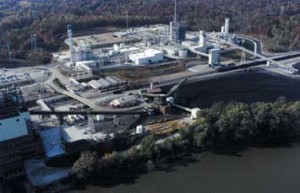More on coal gasification plant explosion
April 29th, 2008
The story of the explosion at the Wabash River coal gasification continues to unfold. The two men killed were identified as Danny Turner and David Shoemaker. Terre Haute News has this report:
================
From a cohort in the know about gasifiers and emissions:
Welcome to the world of high pressure reducing gasification. That’s why I mentioned this possibility before. They call it an “explosion”, but it sounds more like a massive pressure release instead. What’s interesting is that they failed to disclose that while the “roar” continued for “5 minutes”, it was releasing 45-60% CO to the environment. If there had been a temperature inversion and low winds, many more people would have died within the “1/2 mile” radius they checked. MSI has this type of gasifier for DRI,and of course Mesaba I alone would be three to six times larger than Wabash (depends on standby status).
See if you can find out the cause of death of the workers. It might be (instant) CO poisoning (a much more typical accident unless there was a fire too).
================
Emergency response has always been a primary concern of Ron Gustafson, a member of mncoalgasplant.com, my client in our opposition to the Excelsior Energy proposal for the Mesaba IGCC project. He works on emergency response issues professionally, and knows enough about the inherent dangers and probabilities to challenge the adequacy of their plan, equipment, training, and funding for emergency response at the proposed Mesaba Project plant. In this case, the plant was evacuated, local responders were called, and the blast was felt miles away from the plant. We’ll learn more about what happened and what was required of first responders in the coming weeks. It sounds like plant management did all they could in a bad situation. As to causation, I’m wondering what the problem was they were working on, if there’s been a history of corrosion, bolt cracking or similar failures, and then why they were up there in the first place, tightening bolts, indicating that they were loose, when the plant was running.

Leave a Reply